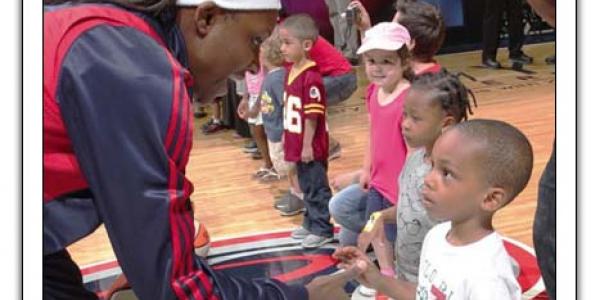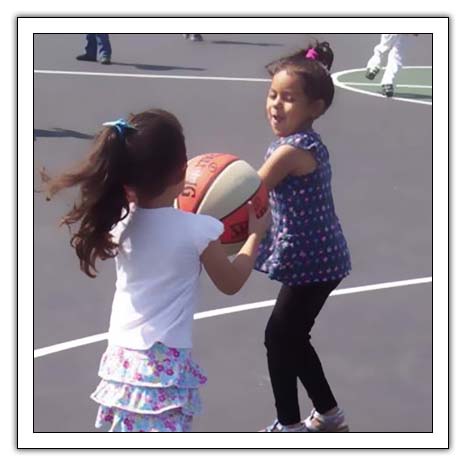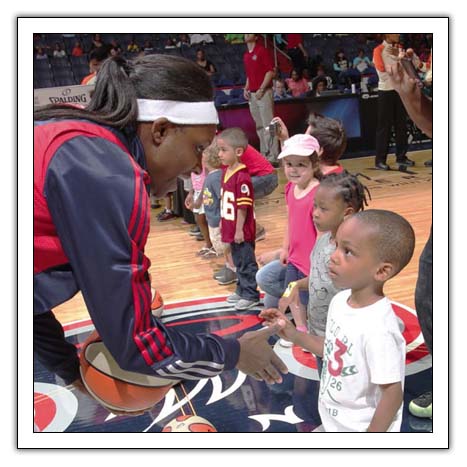Following Your Passion: Introducing Young Children to Basketball

You are here
“Girls don’t play basketball!” Eric, a 4-year-old in Ms. Alina’s pre-K class, insists. He is clutching a small basketball to keep it away from a girl in his class. Shaniya responds, “Hey, I can play! Ms. Alina, tell Eric girls play basketball.” Ms. Alina kneels down with the two children and says, “Hmm, let’s find out if both boys and girls can play basketball.” Ms. Alina turns to me and says, “I’m glad we scheduled a field trip to the Mystics game!” We discuss other ways to engage the children in learning more about women playing basketball and the WNBA (Women’s National Basketball Association).
For almost 20 years I have shared my passion for women’s basketball with countless children, teachers, and families. My love of the game was inspired by my grandmother, who played basketball in high school and by my father, who shot baskets with me as a child. I played throughout school and young adulthood, and the sport continually brings joy into my life.
When teachers are excited and feel strongly about a topic, that passion is contagious. Their plans and interactions contain a unique spark that engages the children in meaningful ways. At first, children are drawn in because of their connections with teachers. Soon their interest grows and they are making their own discoveries.
Share your passion
As a teaching coach and consultant, part of my work includes helping preschool teachers discover their own passions. Some catch the basketball spark and continue to follow the WNBA with the children. Others identify their own special interests such as animals, nature, quilting, cooking, blues music, and naval ships. What continues to amaze and inspire me are children’s deep experiences and discoveries about a topic that is of particular interest to their teacher.
When teachers share things they love, things they feel joyful and passionate about, they inspire children to join in. Children see that their teachers continue to pursue and learn more about their special interests.
Find out what the children know
When Ms. Alina began as a pre-K teacher in one of the programs for which I consult, we talked at length about curriculum strategies that are inviting and engaging for children. After discussing possibilities and sharing stories of our teaching, Ms. Alina chose to work with me and the children to learn more about women’s basketball. I would model how to engage the children in learning about something that was one of my great loves.
We began our investigation by charting what the children already knew about basketball and what they wanted to discover. We created a web to display and document the children’s ideas and capture their questions about basketball. Kayla wanted to know how tall you had to be to play basketball. Jerald asked, “Are the players giants?” Other children came up with ideas on how to play basketball. Ms. Alina and I asked the children some questions too: How do you think basketball is played? Have you ever seen basketball played near your home or on TV? Do you own a basketball hoop? Do you know the names of any basketball players or teams?
Pick a team
Ms. Alina’s class chose to follow the Washington Mystics, a women’s professional team, and several local women’s high school and college teams. The children picked two other WNBA teams to compare to the Mystics: the New York Liberty and the Los Angeles Sparks. In the classroom, Ms. Alina put up a team poster and a map of the United States with marks identifying the cities with WNBA teams.
Learn about basketball and more
When we added a basketball hoop to the classroom, Shaniya took one of the small basketballs and called out, “Hey, I can dribble!” Many of the children did not know what Shaniya meant by the word dribble. Ms. Alina and I planned a variety of different activities to introduce new vocabulary, learn how to play the game, encourage dramatic play (the children set up a concession stand!), as well as explore math and social studies ideas.
The following are examples of the children’s activities and learning.
Language and literacy
Reading about a topic and learning related vocabulary can introduce children to a new subject in an easy and engaging way.
- Learn new vocabulary. Write the words on a chart or on your word wall. Shaniya loved the word dribbling and bounced the basketball over and over until she could dribble like a “real lady basketball player.”
- Get to know the names of teams, players, and coaches. Print and post photos from the teams’ websites. Children can learn the players’ numbers, positions, and fun facts.
Math
Math is integrated in basketball in several ways. Each player has a number. The game is played in defined time periods. Different types of baskets are worth different points.
- Play the game and keep score. Samantha, a 3-year-old, tallied each basket made on a whiteboard and announced on a regular basis, “Blue team has the most!”
- Track the results. As the season progresses, do a bar graph tracking the scores of the team the class has chosen to follow.
- Compare heights of players to each other and to the children.
Sportsmanship
In a world filled with men’s sports, studying women’s basketball and the WNBA lets preschoolers see women as strong, positive role models who contribute to the success of their team. One preschooler, Tahlinda, began attending Washington Mystics games with her mother. Enamored with the players and the children’s dance team on the court, she joined a recreational basketball group. Her mother often comments that the Mystics players were wonderful role models for Tahlinda.
-
 Use the concept of team to discuss working together. “How is being on a basketball team similar to the ways we work together in our classroom?”
Use the concept of team to discuss working together. “How is being on a basketball team similar to the ways we work together in our classroom?”
- Explain sportsmanship. After taking the class to a game, Ms. Alina discussed how the players who lost the game must have felt. Marcus noticed, “They shook hands at the end of the game.” To build on this experience, Ms. Alina and the children discussed how we can be good sports even when we are sad or disappointed.
- Create a sportsmanship award. Have the children nominate classmates who have done something to show good sportsmanship.
Music and dramatic play
Sporting events often feature activities to keep the crowds entertained at halftime. Think about mascots, chants, music, magicians, acrobats, dancers, and more.
- Plan and perform a halftime act. Selena, a 4-year-old, loved the dance team at the Mystics games. Ms. Alina made a tape of music played at the games, and Selena choreographed her own dance. As a result, Selena got to join the dancers at an open practice and then performed at a game.
- Create a class mascot. Children love to see the team mascots’ antics and dances at a game. Make your own mascot masks or decide on a classroom mascot of your own.
Social studies
Basketball involves more than players. Explore how other people support the team and how they got interested in the sport.
- Talk about related jobs. In addition to players, there are coaches, referees, and athletic trainers. Discuss what these people do to support the team as a whole.
- Invite experts to talk to the class. Seek out middle school and high school female players to visit the class or allow you and the children to attend a practice.
Games, fitness, and health
Basketball players need to be strong and healthy. Explore how physical fitness and nutritious foods build healthy bodies.
- Learn the basics of the game. Preschoolers can practice passing, shooting, and dribbling the ball on a real basketball court or on a small one in the classroom. Ms. Alina hung a small net on the back of a door and provided soft basketballs and a whiteboard to use as a scoreboard. Model how to shoot the ball into the hoop and then show the children how to mark and total the scores on the whiteboard.
- Introduce related physical activities. Talk about how the players not only practice basketball, but also need to stretch their bodies and do strength training. Set up an area where children can stretch, bounce some small basketballs, or do jumps to reach high.
Art
Color plays an important role in sports. Teams distinguish themselves based on the color of their uniforms.
- Use team colors. Do art projects that use the main colors of the team.
- Make a logo. Team logos are often as important as the name of the team. Children can explore team logos and create their own.
Family involvement
Basketball is a popular sport. Families can support children’s interest by talking and reading about basketball and playing preschool-level versions of the game.
- Take a field trip. Invite families to join you at a basketball practice or game. Every year I took my preschool class to a Washington Mystics game, and today I help other classes do it, too.
- Turn families into fans. Encourage families to clip sports columns from the paper, print articles from the web, or bring in newspaper sports sections. Collect and post articles where children can see them. Juan’s mother commented that it was hard to find articles about how women’s teams were doing. She had played in college and shared pictures of herself in uniform with the class.
- Help educate parents about the importance of involving children in fitness and sports activities. Share information about how good nutrition, fitness, and playing sports are related to success in school and life.
Conclusion
 As part of the basketball study, Ms. Alina’s class attended a Mystics game. The children wore jerseys they had made, held up signs to support the team, and cheered, sang, and danced to show their enthusiasm. Eric joyously turned to me in the middle of the game and shouted, “These ladies can play basketball!”
As part of the basketball study, Ms. Alina’s class attended a Mystics game. The children wore jerseys they had made, held up signs to support the team, and cheered, sang, and danced to show their enthusiasm. Eric joyously turned to me in the middle of the game and shouted, “These ladies can play basketball!”
Back at their program, the children continued their basketball games. Instead of the blue and red teams, they became the Washington Mystics and the New York Liberty. Former Mystics player Alana Beard came to the school to read with the children and talk about her job as a basketball player. Family members who attended the game with the class began going regularly with their children. They are on their way to becoming lifelong fans.
Sharing something I care about with young children, families, and other teachers has been incredibly rewarding. I now raise funds to bring as many children and families to a WNBA game as possible. Author and professional development provider Margie Carter has discussed creating a place for “bringing ourselves to the teaching and learning process.” By sharing my passion for women’s basketball and the WNBA for more than 16 years, I have passed down a love of the sport that came from my grandmother and father.
What would you like to pass on to the children with whom you work?
Jacky Howell, MA, has worked in the field of early childhood education for more than 40 years. She worked at the Kensington/Forest Glen Children’s Center as a teacher and assistant director and at Montgomery Child Care Association’s Training Institute teaching courses, giving workshops, and keynoting for many years. She currently works as a consultant and trainer for early childhood programs in the Washington Metropolitan area and as a speaker and presenter internationally.
